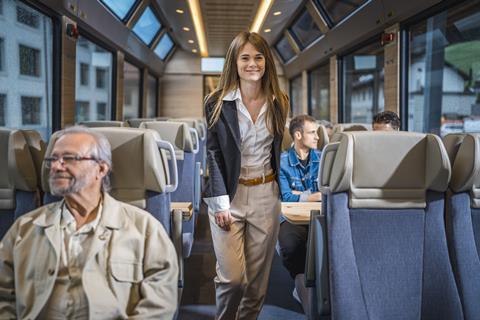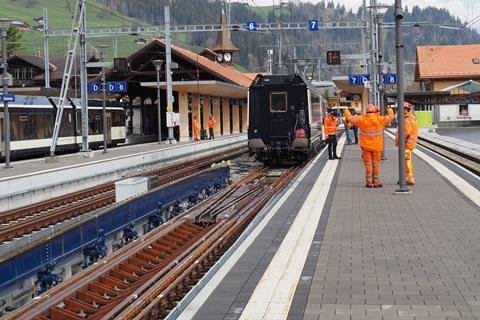
SWITZERLAND: December 11 will mark the start of a long-awaited through service by luxury train between Interlaken and Montreux. Operated by Montreux-Oberland Bahn and BLS Lötschbergbahn, the gauge-changing GoldenPass Express service is expected to become a major attraction between the two lakeside resorts that will help revive tourist travel in the wake of the Covid-19 pandemic.
Using a fleet of Stadler-built panoramic coaches with gauge-changing bogies, the first GoldenPass Express train in commercial service is scheduled to depart Interlaken Ost at 09.08; its eastbound counterpart will leave Montreux at 09.35. Journey time for the 115∙3 km trip through three cantons, including 11 intermediate stops and the change between 1 000 mm and 1 435 mm gauge at Zweisimmen, will be 3 h 15 min.
MOB and BLS will initially operate a daily single service in each direction, but this will increase to four return workings a day from June 2023. Departures from Montreux will be at 07.35, 09.35, 12.35 and 14.35; from Interlaken trains will leave at 09.08, 11.08, 14.08 and 16.08.
Fleet

Rolling stock for the GoldenPass Express will consist of 23 aluminium-bodied panoramic cars assembled in Bussnang by Stadler Rail, 19 of which were delivered between September 2020 and the end of 2021. A further four cars featuring low floors and central entrance doors were ordered later, and these will be delivered in 2023 or early 2024. The fleet will be formed into four sets, three of which will be needed for the June 2023 timetable; the fourth set will be held in reserve or undergoing maintenance.
Each trainset will consist of one end car with ‘prestige’ and first class seats, one first class car, one second class car with low floor, one conventional second class vehicle and one end car with prestige and second class seats. The streamlined train end design was developed by PininFarina, and the car interiors were styled by Innova Design.
Until the low-floor cars are delivered, each set will be formed of four cars hauled by a Ge4/4III locomotive between Montreux and Zweisimmen, where a 1 435 mm gauge car interfacing with a BLS Class 465 locomotive will be attached for the journey to Spiez and Interlaken. The interface car has a standard UIC coupling and buffers at the locomotive end with MOB’s central autocoupler at the other.
On both railways the trains will operate in push-pull formation, with the locomotive always marshalled at the Zweisimmen end of the train.
Capacity will initially be 145 passengers, rising to 184 once the low-floor cars have been added to the formations. On the Zweisimmen – Interlaken Ost leg of the journey, a further 54 second class seats will be available in the interface car.
Nine rotatable and reclinable heated seats in prestige class in each end car will offer a forward or rear-facing view with at-seat service of meals and drinks. Seating in first class will be arranged 2+1 with an at-seat meal service, while second class has 2+2 seating and catering from a minibar trolley. Meal service in prestige or first class will require advance reservations, and products on offer will be locally produced where possible. Catering is to be provided by a subcontractor to MOB.
One-way adult fares for the Montreux – Interlaken trip have been set at SFr53 in second class plus SFr20 for a reservation. The first class fare is SFr93 plus the SFr20 reservation fee or SFr35 for a prestige class seat.
Gauge-changing bogies

The gauge-changing bogie design has been under development by MOB since 2007, with a prototype built the following year. Four EV09 bogies were built in 2010 for testing and demonstration purposes before further development work was awarded to Alstom, leading to the EV18 design chosen for production of 58 bogies at the company’s Villeneuve works; regular bogie maintenance will also be undertaken there by RailTech while other car maintenance work will be handled by MOB in its workshops at Montreux, Chernex and Zweisimmen.
The gauge-changing installations on two tracks at Zweisimmen required considerable remodelling of the station and trackwork; among the challenges to be overcome were different platform heights of 350 mm and 550 mm. This requires the height of the GoldenPass Express cars to be adjusted during the gauge transfer process, which entails lifting the car bodies off the bogies to allow the gauge adjustment to take place. Gauge-changing trials began in 2019, and during the tests the bogies passed through the gauge changers more than 1 000 times.
Zweisimmen also marks a change of power supply ― the MOB is wired at 900 V DC while BLS trains operate under 15 kV 16∙7 Hz catenary. Timetables allow for the entire gauge-changing process to take 8 min.
Funding

MOB puts the total cost of the project at SFr89m. The funds took the form of a loan on the financial market as the project is categorised as a formal regional transport scheme. This provided for the costs to be reflected in fares revenue under rules set by the cantons of Bern, Vaud and Fribourg and by federal government under Switzerland’s Regional Passenger Traffic Compensation regulations. Infrastructure costs were fully funded by the Swiss government under the FABI (Finanzierung und Ausbau der Bahninfrastruktur) railway investment programme.
The gauge-changing cars will all be owned by MOB, which uses a contractual leasing arrangement for BLS to haul them over the 52∙9 km of 1 435 mm gauge track between Zweisimmen and Interlaken Ost.
MOB had hoped to launch the through GoldenPass Express service at the end of 2018, but it was forced to delay the start because of difficulties in securing funding. Further delay was then caused by the collapse of tourist travel during the Covid pandemic.
| Technical data for MOB’s GoldenPass Express rolling stock | |
|---|---|
| Motive power | |
| MOB | Ge4/4III Series 8000 locomotives, 900 V DC |
| BLS | Re465 Bo-Bo locomotives, 15 kV 16∙7 Hz |
| Gauge-changing coaches | |
| Type As, first class (4) | 18∙75 m; 26∙51 tonnes |
| Type ABstPrestige/second class (4) | 19∙32 m; 27∙01 tonnes |
| Type Ast, Prestige/first class (4) | 19∙32 m; 27∙00 tonnes |
| Type Bs, second class (4) | 19∙32 m; 25∙80 tonnes |
| Type Bs, second class with low floor (4) | 18∙75 m; 25∙30 tonnes |
| Type Bsi, second class interface car (3) | 18∙9 m; 25∙11 tonnes |
| Train length from May 2023 | |
| MOB route | 120 m |
| BLS route | 140 m |
| Maximum speed | 100 km/h |

















